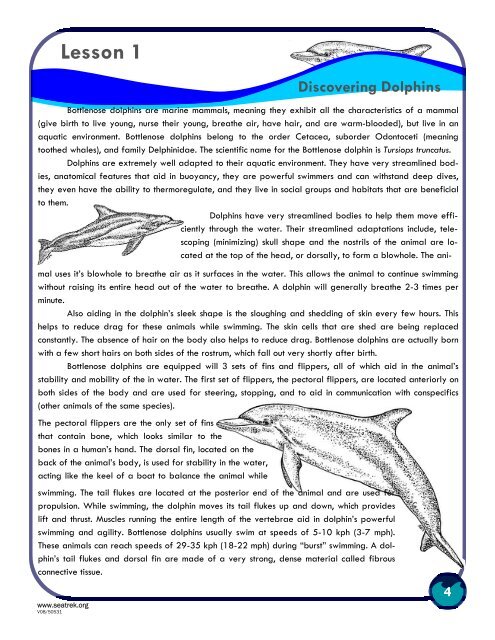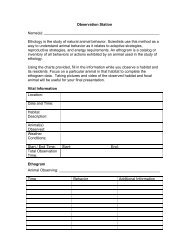LESSON 2 - SeaTrek Programs
LESSON 2 - SeaTrek Programs
LESSON 2 - SeaTrek Programs
You also want an ePaper? Increase the reach of your titles
YUMPU automatically turns print PDFs into web optimized ePapers that Google loves.
Lesson 1<br />
www.seatrek.org<br />
V08/50531<br />
Discovering Dolphins<br />
Bottlenose dolphins are marine mammals, meaning they exhibit all the characteristics of a mammal<br />
(give birth to live young, nurse their young, breathe air, have hair, and are warm-blooded), but live in an<br />
aquatic environment. Bottlenose dolphins belong to the order Cetacea, suborder Odontoceti (meaning<br />
toothed whales), and family Delphinidae. The scientific name for the Bottlenose dolphin is Tursiops truncatus.<br />
Dolphins are extremely well adapted to their aquatic environment. They have very streamlined bodies,<br />
anatomical features that aid in buoyancy, they are powerful swimmers and can withstand deep dives,<br />
they even have the ability to thermoregulate, and they live in social groups and habitats that are beneficial<br />
to them.<br />
Dolphins have very streamlined bodies to help them move efficiently<br />
through the water. Their streamlined adaptations include, telescoping<br />
(minimizing) skull shape and the nostrils of the animal are located<br />
at the top of the head, or dorsally, to form a blowhole. The ani-<br />
mal uses it’s blowhole to breathe air as it surfaces in the water. This allows the animal to continue swimming<br />
without raising its entire head out of the water to breathe. A dolphin will generally breathe 2-3 times per<br />
minute.<br />
Also aiding in the dolphin’s sleek shape is the sloughing and shedding of skin every few hours. This<br />
helps to reduce drag for these animals while swimming. The skin cells that are shed are being replaced<br />
constantly. The absence of hair on the body also helps to reduce drag. Bottlenose dolphins are actually born<br />
with a few short hairs on both sides of the rostrum, which fall out very shortly after birth.<br />
Bottlenose dolphins are equipped will 3 sets of fins and flippers, all of which aid in the animal’s<br />
stability and mobility of the in water. The first set of flippers, the pectoral flippers, are located anteriorly on<br />
both sides of the body and are used for steering, stopping, and to aid in communication with conspecifics<br />
(other animals of the same species).<br />
The pectoral flippers are the only set of fins<br />
that contain bone, which looks similar to the<br />
bones in a human’s hand. The dorsal fin, located on the<br />
back of the animal’s body, is used for stability in the water,<br />
acting like the keel of a boat to balance the animal while<br />
swimming. The tail flukes are located at the posterior end of the animal and are used for<br />
propulsion. While swimming, the dolphin moves its tail flukes up and down, which provides<br />
lift and thrust. Muscles running the entire length of the vertebrae aid in dolphin’s powerful<br />
swimming and agility. Bottlenose dolphins usually swim at speeds of 5-10 kph (3-7 mph).<br />
These animals can reach speeds of 29-35 kph (18-22 mph) during “burst” swimming. A dolphin’s<br />
tail flukes and dorsal fin are made of a very strong, dense material called fibrous<br />
connective tissue.<br />
4





